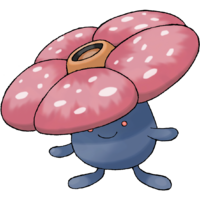Vileplume (Pokémon): Difference between revisions
(→Pokédex entries: changed format and added pearl pokedex entry) |
|||
| Line 65: | Line 65: | ||
=Game data= | =Game data= | ||
==Pokédex entries== | ==Pokédex entries== | ||
{{Dex | |||
|type=grass | |||
|gen=1 | |||
|redbluedex=The larger its petals, the more toxic pollen it contains. Its big head is heavy and hard to hold up. | |||
|yellowdex=Flaps its broad flower petals to scatter its poisonous pollen. The flapping sound is very loud. | |||
|golddex=It has the world's largest petals. With every step, the petals shake out heavy clouds of toxic pollen. | |||
|silverdex=The bud bursts into bloom with a bang. It then starts scattering allergenic, poisonous pollen. | |||
|crystaldex=By shaking its big petals, it scatters toxic pollen into the air, turning the air yellow. | |||
|rubydex=Vileplume's toxic pollen triggers atrocious allergy attacks. That's why it is advisable never to approach any attractive flowers in a jungle, however pretty they may be. | |||
|sapphiredex=Vileplume has the world's largest petals. They are used to attract prey that are then doused with toxic spores. Once the prey are immobilized, this Pokémon catches and devours them. | |||
|emeralddex=In seasons when it produces more pollen, the air around a Vileplume turns yellow with the powder as it walks. The pollen is highly toxic and causes paralysis. | |||
|firereddex=Its petals are the largest in the world. It fiendishly scatters allergy-causing pollen from its petals. | |||
|leafgreendex=The larger its petals, the more toxic pollen it contains. Its big head is heavy and hard to hold up. | |||
|pearldex=Its petals are the largest in the world. As it walks, it scatters extremely allergenic pollen. | |||
|}} | |||
==Game locations== | ==Game locations== | ||
Revision as of 19:52, 11 June 2007
|
|
|
| ||||||||||||||
| ||||||||||||||
|
| |||||||||||||
|
| |||||||||||||
| ||||||||||||||
| ||||||||||||||
| ||||||||||||||
|
| |||||||||||||
|
| |||||||||||||
| ||||||||||||||
| ||||||||||||||
| ||||||||||||||
| ||||||||||||||
Vileplume (Japanese: ラフレシア Ruffresia) is a Grass/Poison-type Pokémon.
Biology
Physiology
Gender differences
A female has fewer, but bigger, spots on its petals.
Special abilities
Behavior
Habitat
Vileplume live in grassy plains, and can also be found in tropical areas such as jungles and swamps, where the ground is rich in nutrients.
Diet
Main article: Pokémon food
In the anime
Vileplume first appeared in EP026, being one of the Pokémon owned by the attendants at the Celadon Gym and was also seen at a party in EP040. Those were cameo appearances.
However, its first major appearance was in EP048. The walking rafflesia flower was under the ownership of James's fiancée, Jessiebelle.
A Vileplume was among the Pokémon that were captured and cloned by Mewtwo in Mewtwo Strikes Back.
Ash, Tracey and Jessie were affected by a Vileplume's Stun Spore in EP110.
Groups of Vileplume and Bellossom were feuding with each other in EP239.
Nicolette used a Vileplume to battle May's Munchlax in AG150.
Game data
Pokédex entries
| ||||||||||||||
| ||||||||||||||
| ||||||||||||||
| ||||||||||||||
| ||||||||||||||
| ||||||||||||||
Game locations
| |||||||||||||||||||||||||||||
| |||||||||||||||||||||||||||||
| |||||||||||||||||||||||||||||
| |||||||||||||||||||||||||||||
| |||||||||||||||||||||||||||||
| |||||||||||||||||||||||||||||
In side games
| Game | Location |
|---|---|
| Pokémon Snap | River |
| Pokémon Pinball: Ruby & Sapphire | Evolve from Gloom (Ruby Field) |
| Pokémon Trozei | Secret Storage 3 Mr. Who's Den |
| Pokémon Mystery Dungeon | Evolve from Gloom |
| Pokémon Ranger | Sekra Mountain Range |
Base stats
| Stat | Range | ||
|---|---|---|---|
| At Lv. 50 | At Lv. 100 | ||
HP: 75
|
135 - 182 | 260 - 354 | |
80
|
76 - 145 | 148 - 284 | |
85
|
81 - 150 | 157 - 295 | |
100
|
94 - 167 | 184 - 328 | |
90
|
85 - 156 | 166 - 306 | |
50
|
49 - 112 | 94 - 218 | |
Total: 480
|
Other Pokémon with this total | ||
Type effectiveness
Template:DP type effectiveness
In Generation I, the effectiveness of Bug-type moves is 400.
Learnset
Template:Evolved learnset intro
By leveling up
| Game | Generation I | Generation II | Generation III | Generation IV |
|---|---|---|---|---|
| 44 | Petal Dance | |||
| 53 | Petal Dance | |||
| 65 | Solarbeam |
By TM/HM
Side game data
Evolution
Trivia
Origin
Vileplume, like Gloom, is based on the rafflesia arnoldii, a foul-smelling flower. This Pokémon more strongly resembles the flower than Gloom, which may represent the budding stage of the rafflesia.
Name origin
Vileplume's name comes from a combination of vile and plume. Its Japanese name is a corruption of the word rafflesia.
In other languages
External links
|
|
|

|
This Pokémon article is part of Project Pokédex, a Bulbapedia project that aims to write comprehensive articles on each Pokémon species, as well as Pokémon groups and forms. |
- Pokémon pages lacking disambiguation notices
- Pokémon in the Medium Slow experience group
- Pokémon in the Kanto Pokédex
- Pokémon in the Johto Pokédex
- Pokémon in the Hoenn Pokédex
- Body style ? Pokémon
- Generation I Pokémon
- Grass-type Pokémon
- Poison-type Pokémon
- Dual-type Pokémon
- Pokémon without Hidden Abilities
- Red-colored Pokémon
- Body style Unknown Pokémon
- Gender-unknown Pokémon
- Plant group Pokémon
- Pokémon with a base stat total of 480
- Pokémon whose Special stat became their Special Attack
- Pokémon that are part of a three-stage evolutionary line

